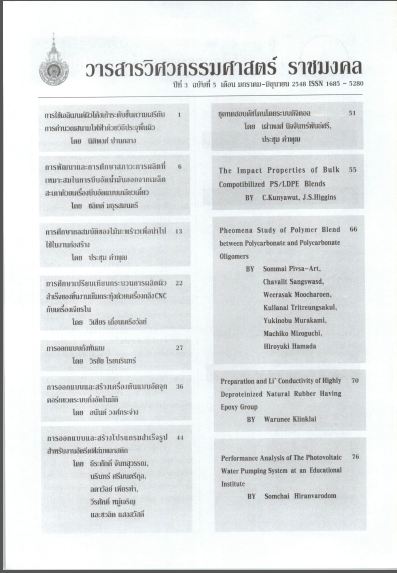The Impact Properties of Bulk Compatibilized PS/LDPE Blends
Main Article Content
Abstract
The impact properties of bulk compatibilized PS/LDPE blends have been studied. Polystyrenc-block-poly (ethylene-butylene) – block- polystyrene (SEBS) triblock copolymer with number average molecular weights (M[subscript n]) of 250,000 and 55,000 were employed as compatibilizers. The PS/LDPE blends with various concentrations of SEBS were prepared by melt mixing using a mini twin screw extruder at a mixing temperature of 180 and a screw speed of 60 rpm. The bulk morphology of the blends was studied using optical (OM), electron (SEM) and atomic force (AFM) microscopy. From these techniques the size and size distribution of the rubbery phase were obtained. Clear evidence of droplet type morphology was found in most samples. The SEBS copolymers have the effect of reducing the interfacial tension between the homopolymers, as indicated by the smaller dispersed phase dimensions when small amounts of the SEBS copolymers were added to the blends. The low molecular weight copolymer was found to be superior to the high molecular weight one in terms of emulsifying effect. The mechanical properties (impact strength) of the blends were studied using a standard charpy impact instrument. Little increase in impact strengths of the blends was observed in the uncompatibilized blends. A further increase in impact strength was obtained in the SEBS compatibilized blends. However, the marginal increase in the impact strengths of the both the uncompatibilized and compatibilized blends indicated the LDPE has low potential in toughening PS.
Article Details
The manuscript, information, content, picture and so forth which were published on Frontiers in engineering innovation research has been a copyright of this journal only. There is not allow anyone or any organize to duplicate all content or some document for unethical publication.
References
Brown, H. R., J. Mater. Sci., 8 (1973):941.
Brown, H. R., J. Mater. Sci., 17 (1982):469.
Brydson, J. A., "Flow Properties of Polymer Melts ", 2nd ed., George Godwin Limited,
London, 1984.
Bubeck, R. A., Buckley, D. J., Kramer, E. J. and Brown, H. R., J. Mater. Sci., 26 (1991):
Bucknall, C. B., "Toughening Plastics".Applied Science Publishers Ltd., London.1977.
Bucknall, C. B.,"Deformation Mechanisms in Rubber-Toughened Polymers", in "Polymer Blends", Vol. 2, Paul, D. R. and Bucknall, C. B., eds. , John Wiley & Son Inc., New York, 2000.
Bucknall, C. B., Rizzieri, R. and Moore,D. R., Polymer, 41 (2000): 4194.
Bucknall, C. B. and Street, D. G., SCI Monograph No. 26 (1967): 272.
Char, K, Brown, H. R. and Deline, V. R, Macromolecules, 26 (1993): 4164
Cigana, P., Favis, B. D., Albert, C. and VuKhan, T., Macromolecules, 30 (1997):4163.
Donald, A. M.,"Crazing" in "The Physics of Glassy Polymers" 2"d ed., Haward, R. N.
and Young, R. J., eds., Chapman & Hall,London, 1997.
Hong, B. K. and Jo, W. H., Polymer, 41(2000): 2069.
Leibler, L., Makromol. Chem. Macromol.Symp., 16 (1988): 1.
Matos, M., Favis, B. D. and Lomellini, P,Polymer, 36 (1995): 3899.
Noolandi, J and Hong, M. K., Macromolecules,15 (1982): 482.
Noolandi, J and Hong, M. K,, Macromolecules,17 (1984):1531.
O'Connor, B, Bucknall, C. B. and Hahnfeld,J. L, Plastic Rubber and Composires and
Applications, 26 (1997): 360.249.
Paul, D. R. and Newman, S., eds., "Polymer Blends" , Volume 2, Academic Press,New York, 1978.
Sperling, L. H., "Polymeric Multicomponent Materials", John Wiley & Sons, Inc.,New York, 1997.
Williams, J. G., "Fracture Mechanics of Polymers", Ellis Horwood Limited, Chichester,
Wu, S., In "Polymer Blends", Volume 2,Paul, D. R. and Newman, S., eds., Academic
Press, New York, 1978.


